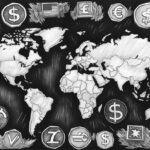New U.S. tariffs 2025 have been rolled out —how will they impact international trade, currencies, and your business or personal finances? Here’s what to expect.
Table of Contents
📌 First, What Is a Tariff?
A tariff is a tax placed on goods imported from another country. It’s designed to make foreign products more expensive—giving domestic producers a competitive edge.
Think of it like a toll on international products. The higher the tariff, the more it costs to bring foreign goods into the country.
Governments use tariffs for a few main reasons:
- To protect local industries
- To raise revenue
- Or, as in this case, to correct imbalances in trade relationships
Now that you know the basics, let’s dive into the new policy.
🔍 What’s Changing post new u.s. tariffs 2025?
On April 2, 2025, the U.S. government unveiled a bold new tariff policy to promote economic fairness and boost domestic industry. The new system includes:
- A 10% flat import tariff on most goods
- A “reciprocal tariff” model that raises rates for countries with high trade barriers against U.S. exports
While the intent is to encourage fairer trade relationships, these changes are stirring uncertainty in international markets, especially regarding pricing, supply chains, and currency values.
🌐 What Are Reciprocal Tariffs?
The idea is simple: if a country imposes high tariffs on American exports, the U.S. will respond with a comparable tariff on their imports.
These reciprocal tariffs are calculated using:
- Average foreign tariffs on U.S. goods
- Non-tariff barriers (like quotas or regulations)
- Currency manipulation indicators
Some countries now face U.S. tariffs of up to 49%. This has put tremendous pressure on the economies of those countries, and the blame goes to the Trump administration’s new U.S. tariff 2025 policy.
📊 U.S. Tariffs by Country (2025 Update)
| Country | Tariffs on U.S. Goods | U.S. Tariffs in Response |
|---|---|---|
| China | 67% | 34% |
| Vietnam | 90% | 46% |
| Cambodia | 97% | 49% |
| India | 52% | 26% |
| Japan | 46% | 24% |
| EU | 39% | 20% |
| UK | 10% | 10% |
| South Korea | 50% | 25% |
| Bangladesh | 74% | 37% |
💱 How Tariffs Impact Currency Exchange
Well, tariffs don’t just raise prices—they can shake up foreign exchange markets. Here’s how:
- Fewer Imports = Less Demand for Foreign Currencies
A drop in U.S. imports can weaken exporting countries’ currencies. - Weaker Currency = Cheaper Exports
A country hit with tariffs may benefit from a currency dip, making its goods cheaper globally. - Stronger U.S. Dollar = Mixed Blessing
A stronger dollar can ease import costs for Americans but hurt U.S. exporters.
🌍 Country-by-Country Currency Impact
🇨🇳 China (USD/CNY)
A 34% tariff puts pressure on Chinese exports, but currency effects are limited due to China’s strict controls and frequent USD-based transactions.
🇪🇺 European Union (USD/EUR)
A 20% tariff could weaken the euro if trade volumes fall. A weaker euro might help EU exporters regain their footing.
🇯🇵 Japan (USD/JPY)
A 24% tariff impacts key sectors like auto and electronics. The yen may strengthen due to market caution, hurting export competitiveness.
🇮🇳 India (USD/INR)
A 26% tariff hits major sectors like textiles and pharmaceuticals. The rupee may face depreciation as export revenues decline.
🌏 Southeast Asia (USD/VND, USD/THB, USD/IDR)
Countries like Vietnam and Cambodia face high tariffs (up to 49%), which could significantly weaken their currencies and strain supply chains.
🇬🇧 United Kingdom (USD/GBP)
Tariffs remain at 10%, maintaining stability for now, but global volatility could still affect GBP exchange rates.
🏢 What Businesses Need to Know
- Adjust Pricing Models: Costlier imports may require contract and pricing changes.
- Diversify Supply Chains: Look to lower-tariff markets or domestic suppliers.
- Manage FX Risk: Use tools like forward contracts and currency hedging to protect margins.
👤 What It Means for You
- Shopping Overseas? Expect price changes and potential delays.
- Sending Money Abroad? Watch for currency shifts that affect transfer values.
- Studying or Buying Property Internationally? Budget for exchange rate swings and added costs.
⚠️ Final Thoughts: Opportunity or Disruption?
While the new tariff system aims to rebalance trade, the ripple effects could be far-reaching. From higher costs and supply chain shake-ups to currency volatility, businesses and consumers must stay alert and adaptable.
✅ Stay Prepared
Whether you’re managing a global business or sending money to family abroad, understanding the impact of these policy changes is key to making smart financial decisions.
Want more insights? click here to read on more…







